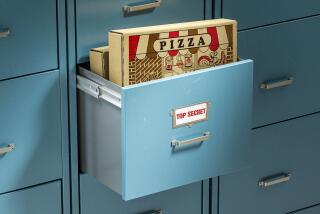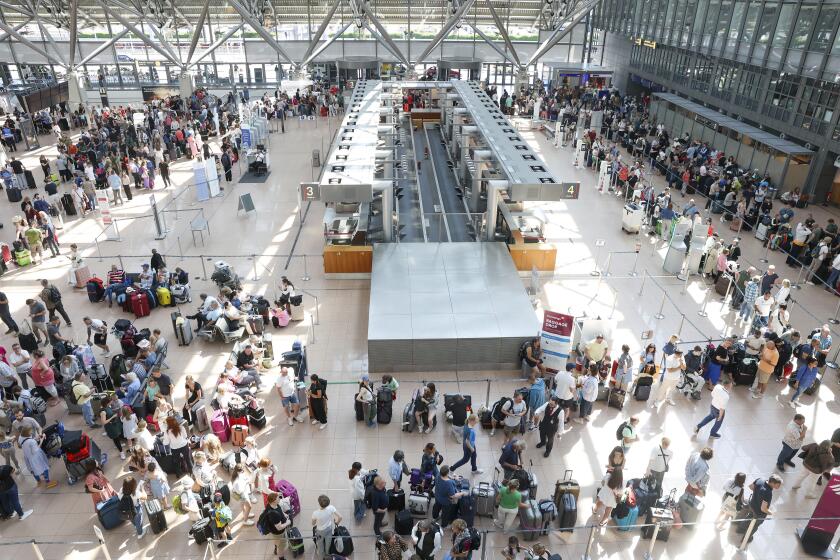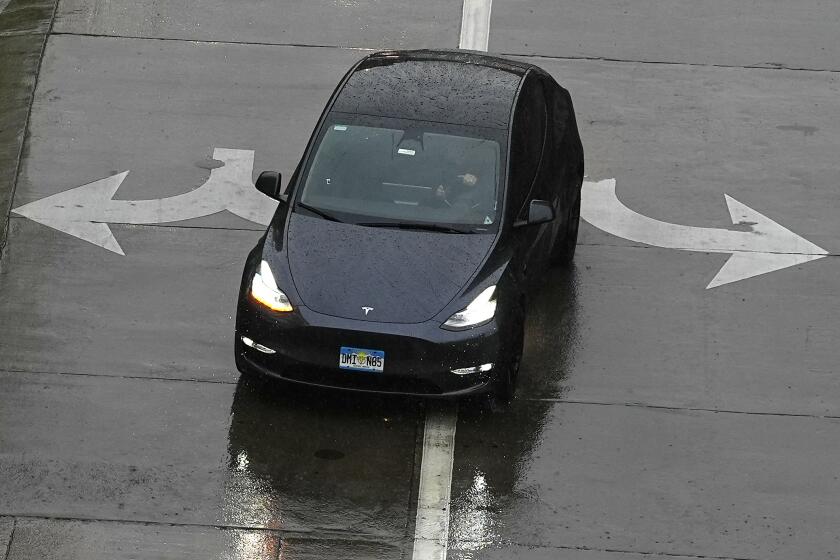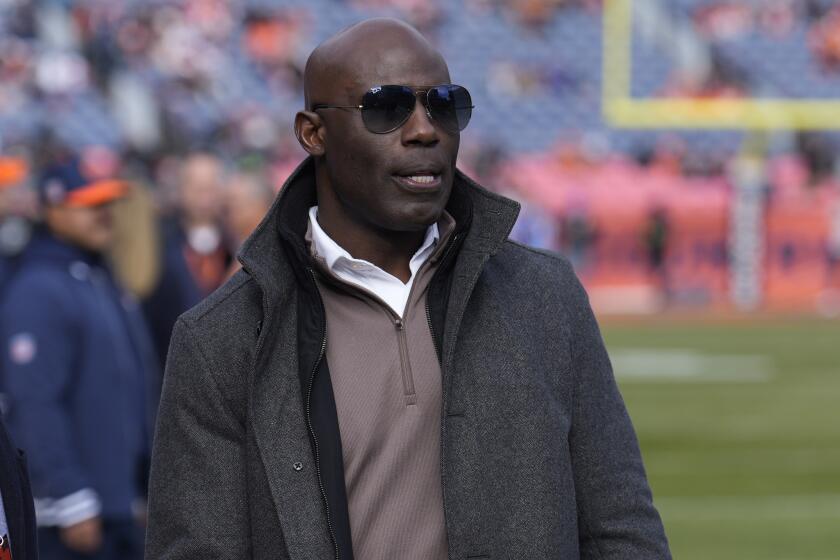Western Avenue: An Urban Biopsy : Thoroughfare Mirrors L.A.’s Rich Mix of Cultures and Life Styles
For 100 years, the 28-mile horse path that became Western Avenue has traversed Los Angeles from green hills to churning ocean, a straight spindle of roadway around which generations have wrapped the threads of their lives.
Western began as a penciled section line, plotted in 1853 by a surveyor named Henry Washington. For years it was no more than that--too far west of the old Los Angeles pueblo to be anything but a horizon.
The road starts at Griffith Park, the one-time Rancho Los Feliz, on land sold in the last century for $1 an acre. From the mossy dells where, legend has it, the Cahuenga Indians once held their councils, it dips down through tawdry parts of town and struggling parts of town. It moves through the poor and aging, then through busy industrial parts of town and rises into sunny and prosperous parts of town, curving like a fisherman’s hook before it ends at the sea cliffs in another long-ago rancho, the Rancho San Pedro.
Western Avenue is an urban biopsy, slicing through most of what the city has become--the young and the elderly, the settled and the restless, Koreans, Latinos and blacks, the lunch-bucket families and the briefcase families.
Western Avenue became a thoroughfare earlier than most streets--it was the way home, not home itself. It cuts its unprepossessing miles north and south through a city that is east-west in its biases, its styles, its vision. The streets whose names do carry personality--Sunset, Wilshire, Century--lattice the length of Western, defining its character a few miles at a time.
In the early and quiet days, before railroad rate wars brought people to Los Angeles from Chicago for $1 a head, the street was a quiet outpost of the downtown pueblo. In 1900, the city’s first country club came to Western, as did one of its best military academies.
Then the city grew up, and grew west, and Western became a street of commerce. It was on Western that the first portable Van de Kamp’s windmill shop appeared, where girls in Dutch costumes sold baked goods out of a little window. There was an ice cream shop shaped like a cup, a diner made like the 20th Century Limited and a huge Donut King that still presides over the street that boasted one of the town’s first “automotive laundries.”
But the years have changed Western. Where Hollywood’s stars once filmed movies, Hollywood’s polyglot population now shops at a vast discount store.
Beyond, to the south, Western is the perimeter of Koreatown--block after block of shiny new Korean-language business signs beckoning the newly arrived and newly prosperous Koreans. Below the Santa Monica Freeway, small black-owned shops work to compete with big chain stores along a street that was once, says a black leader, the “38th parallel” of segregation for black families.
At the edge of the South Bay, where Japanese-American families began to settle long before the animosities of World War II, small industries crowd along the busy street; and down toward San Pedro, where Western was a dirt trail of recent and dusty memory, the hillside condos are beginning to crowd out the coyotes that roamed the hills.
Western Avenue came into the city in fits and starts; it was a busy thoroughfare in Hollywood in the 1920s, when it was still an ambling horse path in San Pedro. Much of it is the backbone of the 1906 Shoestring addition, the gerrymandered ribbon of land 15 miles long and barely half a mile wide, which eventually tied the sprawling square of city to its distant harbor.
On Western Avenue, in glade-crested hills west of the pueblo, rumor that has aged into legend holds that Joaquin Murrieta, the dashing 19th-Century highwayman, once buried a cache of still-undiscovered treasure.
On Western one day in 1905, a local story holds that a little boy named Adam Walsh--who would grow up to captain the famous Four Horseman football team at Notre Dame, where he played center for the “Seven Mules” front line--came barreling down the dusty road toward his home, crying that a lion was after him. The men found their guns and shot it, on Western between Hollywood and Franklin.
On Western Avenue, in the pristine spring twilights before World War I, the girls at Immaculate Heart School would say their prayers in the little replica of the grotto of Lourdes and then stand on tiptoe on the small bridge nearby to look down the street and see Catalina Island.
Some of those 80-year-old Moorish-style school buildings, now home to the American Film Institute, still sit on 15 acres at the summit of Western, where, in other school buildings, uniformed schoolgirls still attend classes. In the summertime of the genteel days of the film trade, recalled a nun who was graduated from there in 1913, movie-making fathers would let their daughters’ classmates see films before they were released and lend them movie costumes for their school plays.
What is left of the Hollywood ambiance along Western Avenue is mostly at AFI, in vast libraries full of scripts and films, and even in a bit of graffiti at a basement pay phone: “For A Good Time, Call Boom Boom La France at Tiny Naylor’s.”
At one time, Western Avenue was to have extended farther north--beyond Griffith Park, beyond Sketchley’s Ostrich Farm, which existed before there was a park. In the 1920s, the city of Glendale had planned with great boosterism that its Western Avenue should link up with Los Angeles’ Western.
“Here’s The Big News!” crowed a Glendale newspaper ad of 1923. “Western Avenue Will Be Paved From Glendale To The Sea. . . . Watch Land Values Jump!”
But it never was. In 1927, said Glendale archivist Barbara Boyd, “rather a magnificent flood” took out bridges along the Los Angeles River, including the designated Western crossing.
Instead, the street grew south.
Today it descends at a steep pitch from Los Feliz to Hollywood Boulevard. The houses that once sat along this northernmost portion of Western were at the border of the flossy neighborhoods behind them, where baronial homes still reign.
Hollywood Boulevard begins the wakeful Western, the day-for-night street, gritty and restless. The glamorous, star-embossed sidewalks end 10 blocks west of here; this corner is not the Hollywood the tourists come to see.
A variety store works hard to make it on this unlikely corner, selling gold picture frames, underwear, coin purses, mixing bowls and the like. But “this is a rough corner,” says a cop who patrols the area. “It goes the most part of 24 hours a day.” Many of its denizens, he says, are runaways, hookers, fast-buck artists, backsliding ex-cons.
Two sweet-faced Mormon missionary youths, in neat trousers and white shirts--an astonishing presence here--walk by and nod at the policemen. “How’d you like to dress like that around here?” one of the cops murmured wonderingly.
This street corner, and the spillover from it, are “scum of the earth,” one longtime local said contemptuously. “It’s godawful.”
Realtor Joe George, a member of the Hollywood Chamber of Commerce, has to be more precise. “Just north of say, Hollywood Boulevard, it (Western Avenue property) has been doing pretty good, but that’s about it. You go south of Sunset, it’s fair, but in between it’s neither here nor there. You take the corner of Hollywood and Western, it’s one of the worst corners--prostitution, massage parlors, bars. People are now just trying to forget Hollywood Boulevard.”
Prospective buyers, he added, “don’t want to go east of Vine. Near Western, they won’t touch it.”
When the building at Hollywood and Western was built in the late 1920s, it caused a minor scandal: The stonework friezes carved on its balconies showed movie directors, cameramen, soundmen and others in classical Greek style--which is to say, barely draped. Today, the women who lounge across the street in short shorts and T-shirts do not draw a second glance.
In the building’s basement, in the cool and gentlemanly quiet of a venerable billiard room, one regular had strong words for what the corner has become--the game arcade, the bars, the street people who frequent them. “If it weren’t for that,” he sighed, “we’d have a nice neighborhood.”
Because of them, “we lost a lot of attorneys and doctors who played three-cushion billiards, the real thing,” said the regular. “They just didn’t want to come into the neighborhood any more. We’ve lost them. They don’t even want to park in that lot. They’re afraid to walk from here to that parking lot, and that’s no lie.”
A 95-year-old former movie writer who lives nine blocks away walks past the street people to the billiard room once a week or so. “He figures at his age,” the regular said, “he has nothing to lose.”
At the equally venerable Falcon Studios a block away, where Hollywood’s movie swordsmen learned to wield a credible foil for a scene or two, the women fencing students “go down the street, sword in hand and a determined expression on their face, and nobody bothers them,” said elegant, 94-year-old Ralph B. Faulkner, an Olympic fencing competitor in 1928 and 1932 who later swashbuckled in scores of films.
For all the problems, it used to be worse.
Former Hollywood Division Police Capt. John White--himself a Hollywood veteran, son of an MGM photographic director and a Harold Lloyd comedienne--said that crime thereabouts “fluctuates, as any other part of the city.”
But more than 15 years back, White said, when the floodgates were loosed on pornography by a series of Supreme Court rulings, there was “a tremendous crime increase” on Western Avenue--prostitution, drugs, burglaries, thefts, assaults. Sidewalk hawkers promoted sex shows, sidewalk hookers promoted themselves.
So in 1975 police moved to stop it, White said. Four officers patrolled each block of Western--30 of them, at one point, at Santa Monica and Western--asking patrons of the 10 porno theaters, topless and bottomless bars, and X-rated bookstores in the eight-block stretch where they were going and why.
“We were saying that we were going to put a police presence on that street and control crime,” White said.
It worked. Within a few years, he said, most of the bookstores and sex clubs closed, and the hookers moved elsewhere. “I think what happened is, the public got its fill. . . . A lot of them went out of business after they’d gotten it out of their system.”
One man who kept his business on Western Avenue for 21 years was a sturdy supporter of cleaning up the neighborhood.
Vincent Miranda, the pioneering sex-film theater mogul, opened one of his first Pussycat Theatres here in January, 1963, and maintained offices nearby, where he talked to a reporter before his death last month. The man who spent so much time in court that he had a desk nameplate reading “Defendant Vincent Miranda,” said he believed in “working with the police on cleaning up the boulevard, doing something about the gangs and the robberies. . . . If it’s not safe, people won’t walk on that street.”
Miranda, who owned 60-plus theaters, a third of them “general interest,” once said that theater marquees should not be offensive “because you have people going by on their way to church.”
Still, he said, the neighborhood “is coming back up. I see a change in the people--not as many kooks around.”
A quarter-century ago, when 20th Century-Fox still filmed TV shows and B-pictures nearby, “I got used to seeing people in costume, going out to lunch,” Miranda said. “Today, people are still in costume, but it’s really different people.” At a bus stop, for example, he said, “I saw a guy in a skeleton costume.”
In the old days, at the Hollywood-Western corner, the people in costumes were waiting for jobs, not buses. The Motion Picture Assn. of America (MPAA), which codes and rates films, and Central Casting Corp., with its listing of 5,000 would-be actors, were headquartered here until the movies moved away in the 1950s and 1960s. The extras, often costumed to the nines, would loiter in the building’s lobby, hoping for a big break.
“In those days,” recalled Robert T. Watkins, a 32-year MPAA veteran and retired vice president of finance, “you would come out to lunch and there would be dozens of extra players climbing all over you begging for work, and you could hardly shake them loose.”
Still, it was a cozy arrangement, for just down the street at Sunset Boulevard, sprawling on both sides of Western, was 20th-Century Fox.
The site was already a movie lot by 1916, the Thomas Dixon studio, which had just been bought by Fox Studios. Eventually, a pioneering sound stage, a two-story lab and a glass-covered stage would rise in a facility where 660 films would be produced.
The first screen vamp, Theda Bara, worked there briefly. Janet Gaynor too came to work on Western Avenue. So did Clara Bow, John Gilbert, Will Rogers, Tom Mix and a dog named Thunder.
“What Price Glory” came out of there, as did “The Iron Horse,” and such lesser lights as “Ankles Preferred,” “Second Hand Love,” and in the California sunshine, the unlikely title, “30 Below Zero.”
In the 1940s came the B-movies--the Cisco Kid, Charlie Chan. Producers of big musicals came over from the new studios that had located farther west to borrow the vast sound stages on Western Avenue, said archivist Ken Kenyon.
During the war, director Frank Capra’s Signal Corps unit worked out of the studio, and one day, during the filming of “The Battle of Stalingrad,” an economy-minded executive recruited the unit, including local historian and writer John Weaver, to march back and forth while the camera filmed only the ominous shadows of their rifles and bayonets.
“I’ll never forget,” Weaver chuckled, “fighting the Battle of Stalingrad on Western Avenue.”
In the 1950s and into the 1960s, the studio went to television--”Dobie Gillis,” “Daniel Boone” and “Twelve O’Clock High” were made there. By 1971, Kenyon said, production had long since moved, and most of the Western Avenue studio land had been leased and sold, although film processing still is done there.
Not all of Western Avenue’s veterans have departed. The Callanan brothers grew up in Hollywood. In the 1930s, Michael Joe Callanan took the girl he would one day marry for evening strolls down Western. And when the family mortuary business was forced to move from downtown in the mid-1950s because of the Harbor Freeway construction, they came home to Hollywood, to Western Avenue.
“Hollywood was a family, a residential community,” Callanan, 69, said. “We used to go strolling and meet all our neighbors and friends, like a small hick town. There was nothing on Western Avenue but friendly people.”
One of Callanan’s neighbors, at the edge of the Hollywood Freeway, is a vast building, once coveted for its “sign possibilities” from the freeway, recalled Bill Roberts, a political campaign manager. Mayor Sam Yorty used it as a campaign headquarters in the 1960s; in 1970, a movie actor who has gone on to greater fame used it for his statewide gubernatorial campaign headquarters--Ronald Reagan.
There is still some vestige of the Hollywood dream there; seven nights a week, until 2 a.m., comely young women do perform in front of an audience--in mud-wrestling matches and hot-oil bouts.
More to Read
Sign up for Essential California
The most important California stories and recommendations in your inbox every morning.
You may occasionally receive promotional content from the Los Angeles Times.







